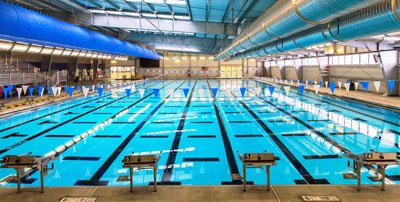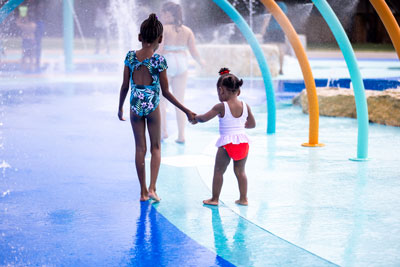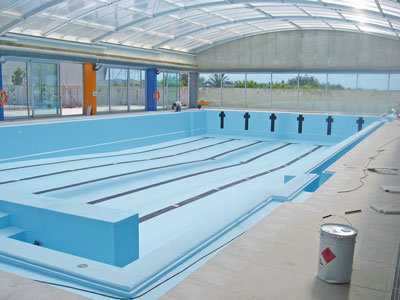There are a lot of aging pools out there, many of which are still in service but are just barely limping along. And while communities overwhelmingly desire access to aquatic facilities, oftentimes these ailing bodies of water struggle to draw visitors, leaking not just water but cash and resources too. But whether a pool simply needs a cosmetic facelift or a major structural or mechanical overhaul, renovating an existing facility can bring it back to life and get visitors excited about coming back to the pool.

With so many facets of pools and support spaces, owners and operators must examine all of these areas to begin to see just what needs repairing, renovating or replacing. Justin Caron is principal and CEO at Aquatic Design Group, which performs facility assessments, providing details related to the condition of existing facilities, and he said they not only assess the condition of the pool and its mechanical systems, they also look for any code violations that could potentially close or restrict facility use.
“Since swimming pool codes are updated over time, the facilities need to keep up with those changes,” Caron said. “Many aging facilities are also exploring replacing outdated or underutilized pools with modern amenities such as moving water, interactive toys and thrill experiences. Competitive facilities are often looking at substantial renovations or replacements to create more versatile bodies of water that can accommodate multiple programs and teams, and growing sports such as water polo.
“When a project budget is tight, renovating rather than replacing the existing pool or mechanical systems can make the most sense,” continued Caron. “This is where a thorough needs assessment study can benefit the owner to gain a better understanding of what improvements should be made and why. In some cases, it can be cheaper to remove and replace the feature versus renovation.”
“Each facility is unique unto itself,” explained Frank Parisi, COO and managing principal at Williams Architects. “We recommend that the team conduct a facilities assessment before a renovation, identifying the opportunity to reuse pool structures and filtration and what can be salvaged in a renovation project. Due to patron expectations and changes in usage, we find that entire renovations of the bathing facilities are required to comply with current international and building code standards.” He added that some of those amenities include additional privacy, gender neutrality and family accommodations.

Darren Bevard is principal at Counsilman-Hunsaker, which also offers audits and assessments. He said these can identify and document deficiencies of an aging facility and begin to outline an appropriate project scope, as the audits analyze a facility from two perspectives: “The physical category would encompass characteristics such as equipment that is nearing the end of its service life as well as code compliance or life safety concerns. Functional obsolescence is consideration of whether the facility is meeting the necessary program and user needs to drive attendance and establish a successful facility pro forma.”
The physical audit includes—but is not limited to—inspection of pool structure and finishes; recirculation systems, piping, fittings and valves; filtration systems and overflow recovery systems; water chemistry treatment systems; pumps, flow meters, gauges and controls; and deck equipment. Additionally, code compliance with state and local health codes and the Model Aquatic Health Code (MAHC) is analyzed.
Sometimes facilities might be functioning satisfactorily even though they could use some updating, so it’s easy to let them chug along as is because budgets are tight. But facilities often find that when they perform even simple upgrades, more visitors are inclined to utilize the facility.
“Renovations and park upkeep are essential to keeping parks fresh and inviting,” said David Keim, director, public market business development at Aquatic Development Group, discussing aquatic parks. “Keeping a park looking and feeling new adds to a positive guest experience.
“Periodically adding or updating attractions provides operators with marketing opportunities, regardless of the age of the park,” continued Keim. “Renovations and/or expansions of existing parks are a big part of our business as parks continue to add attractions and/or rebrand or refresh areas in the park.”
He said it’s common practice for aquatic parks to periodically undergo major renovations “that in some cases result in significant changes to the overall park layout and attraction mix.”

“Pools became popular in the mid-1900s, right?” asked Sophia Young, communications manager at Waters Edge Aquatic Design. “In many cases they were a traditional rectangle with maybe a diving board and small deck space. Those older models of pools have been reaching the end of their life and don’t draw crowds. A community must decide what’s best for them: invest in modernizing the swimming facility, or let it go?”
She said it’s common for facilities to decide to make improvements that add more programming options and expand their user base. “They usually face the decision to renovate when the pool has reached its life expectancy and/or pool patronage is low.”
“In the case of a facility where the entire site has reached the end of its life or has been deemed not feasible or appropriate to renovate, we may be working with a community to determine the appropriate next steps, including the decommissioning of a site and rebuilding a new facility,” said Lauren Ozburn, project manager/operations at Waters Edge Aquatic Design. “A master plan or feasibility study can really help a community understand the options and establish the appropriate recommendation for the future.”
Young agreed, pointing out that it’s difficult to know what’s happening behind the scenes of a facility until an assessment is professionally conducted. “Recommendations can then be made, but budget restrictions—and expected life-expectancy of the major components of the facility—often dictate the best course of action. In some situations it will make financial sense to build new, while other situations will be to repair.”
Added Ozburn, “In the case of a renovation, there are typically areas of the facility that are in working order and can be salvaged and improved upon, allowing for more of the budget to go toward those areas that wow guests and draw attendance.”
Indeed, facility owners/operators must consider the best use of available project funds in terms of replacement versus renovation, said Bevard, especially in light of the recent escalation of construction costs. “Depending on the facility type, existing conditions and project constraints, it often makes sense to consider renovation or repurposing of existing aquatic facility infrastructure.”

He explained that they’ve been involved with renovations and expansions at all levels, including existing pool shells, and complete replacement of pools within an existing building enclosure. “Priorities for these types of renovation projects are often a mix of addressing failing or deteriorating pool conditions as well as addition of features and functionality.”
Renovations often involve mechanical rooms, whether it’s to introduce new equipment as technologies have evolved or to replace worn-out systems. Bevard said these updates are common, and typically due to issues related to aging or failing systems and/or code compliance. “We often come across facilities that are dealing with excessive corrosion in the pool mechanical room areas due to the original design not providing proper isolation or containment of corrosive pool chemicals. That coupled with poor ventilation and humidity control can rapidly shorten the lifespan of pool mechanical systems.”
“Since the mechanical systems are the lifeblood of swimming pools, it’s important to make sure they’re in good working condition to serve patrons,” said Caron. “In addition, we’re seeing a greater number of owners switching to more efficient systems and equipment. Adding variable frequency drives (VFDs) and smart pumps are just two examples of mechanical system improvements.”
Some venues are working to make their facility operations more sustainable. “Designing a facility that’s energy-efficient and sustainable not only makes sense for the environment but also the owner’s budget,” said Caron. “Specifying high-efficiency pumps can result in 20% to 30% greater productivity; VFDs can help reduce electrical use by up to 40%; thermal solar can reduce pool heating by up to 40% as well, among other considerations. Most states’ energy codes now mandate designs to be equivalent to LEED as a baseline. Additional standards like WELL are helping shape healthier, more sustainable and eco-responsible facilities.”
In addition to revamping facilities with fun adventure attractions, the “non-fun” features are also important considerations. “Replacement of deck equipment is common in terms of upgrading an aquatic facility through renovation,” said Bevard. “An example would be replacing older-style stationary lifeguard stands with modern, portable stands, which not only allow flexibility in positioning and ensuring effective coverage of zones, but also are more comfortable and functional. Starting block design has advanced to the point where many aging competition facilities require an upgrade to meet athlete expectations and serve as a training tool for teams who are competing at modern facilities that utilize the latest technology.”

Young said that some older versions of aquatic venues had separate wading pools that might even still be on a fill and drain system, and pointed out that one common transformation seen with older pool designs is converting the wading pool into a splash pad. “It evolves into a colorful space inclusive of individuals of all abilities. No lifeguards are needed in the space, which is a staffing benefit. It adds to the variety of water play at the pool. The space can even be fenced off in a way that the splash pad can open to the public at times that the pool itself is not open and staffed.”
Chris Thomas, director of marketing at a San Marcos, Texas-based designer and manufacturer of interactive water features and aquatic play equipment, also mentioned the kiddie pools of the past, which typically had less than one foot of water and a low wall for parents to sit on. “Unfortunately, with the rise in new aquatic trends, these areas have become dead zones in many parks.”
Thomas said that as parks facilities are looking for ways to generate new interest and attract new patrons to aquatic play areas, converting kiddie pools to splash pads has indeed become a popular renovation option, as these spaces are ideal for all ages and abilities to enjoy.
“If a facility is interested in creating a more inclusive gathering space in their aquatic recreation area, we can help… to really make the splash play area attractive to a much larger segment of the population than any kiddie pool could ever attract.”
Thomas also said it’s possible to utilize existing infrastructure or plumbing. “There are lots of features that are easy to replace using the same pipes and feeds.”

For those renovating or adding amenities to indoor facilities, splash and spray features are also showing up at indoor pools. “This is common for municipal rec facilities and waterparks alike,” said Bevard. But he pointed out that the more water that is aerated within the natatorium, the more evaporation is going to occur. “This means more humidity has to be removed from the space via HVAC… the HVAC design must be able to handle the increased humidity load.”
For those who are looking to add spray features indoors, Thomas said “They are commonly included on decks, in walls and in shallow bodies of water depending on the intent. They do not necessarily require separate mechanical systems from the pools if located within the indoor facility.” Additionally, there are options for reducing water usage with spray features by choosing nozzles with smaller orifices, sequencing features to operate less frequently and/or including a recirculation system.
For leaky pools or pools that are damaged or deteriorating with age, one option is to incorporate a pool liner into the existing structure. Jason Mart is owner of an Indianapolis-based manufacturer of products designed for public swimming pool construction and renovation. They offer a pool shell that’s constructed onsite from a 60 mil reinforced PVC membrane, offering watertight containment. The shell can be installed over most any pool surface, including concrete, fiberglass, tile, stainless steel and aluminum.
“In addition to the textural beauty of a ‘like new’ pool interior, the primary advantage of a reinforced PVC membrane renovation lies in its ability to completely protect the underlying structural materials from the deleterious effects of water intrusion,” said Mart. “Even 100-year-old concrete structures that most engineers would condemn can be first repaired and then encapsulated with the reinforced membrane thus extending the vessel’s life.”

He said the membranes can be adapted to any shape pool and can be used indoors or outdoors.
There’s also a PVC pool deck surfacing product that can be used indoors or outdoors. “Decking issues can be masked by covering over the repaired sections, making the decks much more attractive and slip-resistant,” said Mart. He said the heavily-textured decking is easily cleaned with a cleansing solution and brush. Additionally, “It’s a great locker room solution due to its slip resistance and ease of care.”
Pool recirculation systems are another area targeted during renovations, and Mart’s company offers stainless steel pool gutters available in numerous configurations, though custom designs are also available. “When the PVC membrane is combined with a stainless-steel gutter, it completely ensures the long term viability of the pool facility by completely eliminating all pool edge buried pressure piping.” For indoor use there are also PVC gutters.
Dustin Buckland is vice president of sales and marketing for an international manufacturer of plastic products, including reinforced textured PVC membrane pool liners for new-build or renovation projects. Buckland explained that the membranes offer the option to go on top of almost any surface to provide waterproofing and slip-resistance, “particularly with splash pads and spray parks, which is a growing trend across the country. Whether it’s a splash pool, kiddie pool, zero-entry area or a transition area in a waterpark, (it’s) the product of choice for ease-of-use, long-term performance and economies of scale when compared with a complete take-down and rebuild option.”
The PVC membrane has fungicides included throughout the product, intended to be a backup to pool water sanitizer, according to Buckland. There’s also a multipurpose lacquer included. “It includes light and heat absorbers to protect from the damaging effects of UV light. It also contains anti-stain/soil inhibitors to prevent the development of bacteria and fungi that can be problematic in commercial settings, and finally the lacquer protects against abrasion.”

Joshua Albertson is the sales manager for an Indianapolis-based company that designs, manufactures and installs stainless steel pools and equipment and systems for construction and renovation of pools. One offering is an indoor/outdoor decking solution for wet areas including pool decks, locker rooms and splash pads. “It easily installs over most deck and floor surfaces, especially those that are cracked, worn or in disrepair. It has a slip-resistant textured surface that gives superior comfort for bare feet, unlike concrete or wood that can become hot or slippery.” An acrylic coating making it resistant to staining, chlorine and UV degradation.
In Globe, Ariz., the Globe Community Center swimming pool had been shut down since 2014 due to continuous water loss and mechanical components that were worn out. The concrete gutters had failed along with the perimeter piping. The pool basin was in disrepair and the filtration system wasn’t working. In 2021, renovation plans and discussions were revived and Albertson’s company—which also offers pool facility evaluations and renovation consulting services—became involved.
The pool reopened in 2023 with double the square footage and many amenities including a splash pad, zero-entry area, heater to lengthen the season and new decking. Other products supplied by Albertson’s company included a stainless-steel perimeter gutter system, vacuum sand filtration system, PVC membrane and a moving pool bulkhead to allow competitive swimming. “Working with our pool builder partner, (we) were chosen to provide many aquatic components that would not only extend the life of the pool by many years but would save the city time and money in annual maintenance and allow additional programming to be added.” RM



